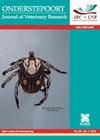The use of plant extracts and bacteriophages as an alternative therapy approach in combatting bacterial infections: the study of lytic phages and Stevia rebaudiana
IF 1.6
3区 农林科学
Q2 VETERINARY SCIENCES
引用次数: 0
Abstract
Abstract Introduction In the light of the problem of antibiotic resistance, the use of combined alternative therapies in combatting bacteria-related disorders has gained popularity. Bacteriophages are one element implemented in new combination therapy. Stevia rebaudiana is known to have antimicrobial activity and regarded as potentially having a synergistic effect with bacteriophages. Therefore, possible interactions of lytic bacteriophages (MS2, T4 and Phi6) with acetone and methanol S. rebaudiana extracts (SRa and SRm) in the bacterial environment were examined. Material and Methods The interactions were tested using a microdilution method, phage-extract co-incubation assay, static interaction (synography) and dynamic growth profile experiments in a bioreactor. Results The interactions of the tested factors in a static environment differed from those in a dynamic environment. Dynamic conditions altered the effect of the extracts in a concentration-dependent manner. How different the effect of the SRa extract was to that of the SRm extract on bacterial growth in a dynamic environment depended on the species of the phage and bacterial host. The greatest differences were observed for E. coli strains and their phages, whereas Pseudomonas syringae and the Phi6 phage reacted very similarly to both extracts. Differences also emerged for the same extract in different E. coli strains and their phages. Conclusion Every extract type should be tested on a case-by-case basis and experiment outcomes should not be generalised before gathering data. Moreover, many varied experiments should be performed, especially when examining such multifactorial mixtures. The tested mixtures could potentially be used in multidrug-resistant bacterial infection treatments.利用植物提取物和噬菌体作为对抗细菌感染的替代疗法:溶噬菌体和甜菊糖的研究
摘要:鉴于抗生素耐药性问题,使用联合替代疗法来对抗细菌相关疾病已经得到了普及。噬菌体是一种新的联合疗法。已知甜菊糖具有抗菌活性,并被认为可能与噬菌体具有协同作用。因此,我们研究了裂解噬菌体(MS2、T4和Phi6)在细菌环境中与丙酮和甲醇瑞波迪亚那提取物(SRa和SRm)的可能相互作用。材料和方法采用微稀释法、噬菌体萃取物共孵育法、静态相互作用(图解法)和生物反应器中的动态生长剖面实验来检测相互作用。结果被测因子在静态环境中的相互作用与在动态环境中的相互作用不同。动态条件以浓度依赖的方式改变了提取物的效果。在动态环境中,SRa提取物与SRm提取物对细菌生长的影响有多大差异取决于噬菌体和细菌宿主的种类。大肠杆菌菌株及其噬菌体的差异最大,而丁香假单胞菌和Phi6噬菌体对这两种提取物的反应非常相似。同样的提取物在不同的大肠杆菌菌株及其噬菌体中也出现了差异。结论每一种提取物类型都应进行具体情况的检验,不应在收集数据前一概而论。此外,应进行许多不同的实验,特别是在检查这种多因素混合物时。测试的混合物可能用于治疗多重耐药细菌感染。
本文章由计算机程序翻译,如有差异,请以英文原文为准。
求助全文
约1分钟内获得全文
求助全文
来源期刊
CiteScore
4.30
自引率
0.00%
发文量
13
审稿时长
16 weeks
期刊介绍:
The Onderstepoort Journal of Veterinary Research, is the official publication of the Onderstepoort Veterinary Institute. While it considers submissions from any geographic region, its focus is on Africa and the infectious and parasitic diseases and disease vectors that affect livestock and wildlife on the continent.

 求助内容:
求助内容: 应助结果提醒方式:
应助结果提醒方式:


